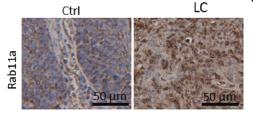RAB11A Antibody - #DF6301
| Product: | RAB11A Antibody |
| Catalog: | DF6301 |
| Description: | Rabbit polyclonal antibody to RAB11A |
| Application: | WB IHC |
| Cited expt.: | WB, IHC |
| Reactivity: | Human, Mouse, Rat |
| Prediction: | Pig, Zebrafish, Bovine, Horse, Sheep, Rabbit, Dog, Chicken, Xenopus |
| Mol.Wt.: | 24kDa; 24kD(Calculated). |
| Uniprot: | P62491 |
| RRID: | AB_2838267 |
Related Downloads
Protocols
Product Info
*The optimal dilutions should be determined by the end user. For optimal experimental results, antibody reuse is not recommended.
*Tips:
WB: For western blot detection of denatured protein samples. IHC: For immunohistochemical detection of paraffin sections (IHC-p) or frozen sections (IHC-f) of tissue samples. IF/ICC: For immunofluorescence detection of cell samples. ELISA(peptide): For ELISA detection of antigenic peptide.
Cite Format: Affinity Biosciences Cat# DF6301, RRID:AB_2838267.
Fold/Unfold
MGC1490; Rab 11; Rab 11A; RAB 11A, member oncogene family; Rab-11; RAB11 A; RAB11; Rab11a; RAB11A member RAS oncogene family; Ras related protein Rab 11A; Ras related protein Rab11A; Ras-related protein Rab-11A; RB11A_HUMAN; YL 8; YL8;
Immunogens
A synthesized peptide derived from human RAB11A, corresponding to a region within C-terminal amino acids.
- P62491 RB11A_HUMAN:
- Protein BLAST With
- NCBI/
- ExPASy/
- Uniprot
MGTRDDEYDYLFKVVLIGDSGVGKSNLLSRFTRNEFNLESKSTIGVEFATRSIQVDGKTIKAQIWDTAGQERYRAITSAYYRGAVGALLVYDIAKHLTYENVERWLKELRDHADSNIVIMLVGNKSDLRHLRAVPTDEARAFAEKNGLSFIETSALDSTNVEAAFQTILTEIYRIVSQKQMSDRRENDMSPSNNVVPIHVPPTTENKPKVQCCQNI
Predictions
Score>80(red) has high confidence and is suggested to be used for WB detection. *The prediction model is mainly based on the alignment of immunogen sequences, the results are for reference only, not as the basis of quality assurance.
High(score>80) Medium(80>score>50) Low(score<50) No confidence
Research Backgrounds
The small GTPases Rab are key regulators of intracellular membrane trafficking, from the formation of transport vesicles to their fusion with membranes. Rabs cycle between an inactive GDP-bound form and an active GTP-bound form that is able to recruit to membranes different set of downstream effectors directly responsible for vesicle formation, movement, tethering and fusion. The small Rab GTPase RAB11A regulates endocytic recycling. Acts as a major regulator of membrane delivery during cytokinesis. Together with MYO5B and RAB8A participates in epithelial cell polarization. Together with RAB3IP, RAB8A, the exocyst complex, PARD3, PRKCI, ANXA2, CDC42 and DNMBP promotes transcytosis of PODXL to the apical membrane initiation sites (AMIS), apical surface formation and lumenogenesis. Together with MYO5B participates in CFTR trafficking to the plasma membrane and TF (Transferrin) recycling in nonpolarized cells. Required in a complex with MYO5B and RAB11FIP2 for the transport of NPC1L1 to the plasma membrane. Participates in the sorting and basolateral transport of CDH1 from the Golgi apparatus to the plasma membrane. Regulates the recycling of FCGRT (receptor of Fc region of monomeric Ig G) to basolateral membranes. May also play a role in melanosome transport and release from melanocytes.
Cell membrane>Lipid-anchor. Recycling endosome membrane>Lipid-anchor. Cleavage furrow. Cytoplasmic vesicle>Phagosome. Cytoplasmic vesicle membrane.
Note: Translocates with RAB11FIP2 from the vesicles of the endocytic recycling compartment (ERC) to the plasma membrane (PubMed:11994279). Localizes to the cleavage furrow (PubMed:15601896). Colocalizes with PARD3, PRKCI, EXOC5, OCLN, PODXL and RAB8A in apical membrane initiation sites (AMIS) during the generation of apical surface and lumenogenesis (PubMed:20890297). Recruited to phagosomes containing S.aureus or M.tuberculosis (PubMed:21255211).
Belongs to the small GTPase superfamily. Rab family.
Research Fields
· Cellular Processes > Transport and catabolism > Endocytosis. (View pathway)
· Organismal Systems > Excretory system > Endocrine and other factor-regulated calcium reabsorption.
· Organismal Systems > Excretory system > Vasopressin-regulated water reabsorption.
· Organismal Systems > Digestive system > Pancreatic secretion.
References
Application: WB Species: Human Sample: HN4 and CNE2 cells
Application: IHC Species: Human Sample: HN4 and CNE2 cells
Restrictive clause
Affinity Biosciences tests all products strictly. Citations are provided as a resource for additional applications that have not been validated by Affinity Biosciences. Please choose the appropriate format for each application and consult Materials and Methods sections for additional details about the use of any product in these publications.
For Research Use Only.
Not for use in diagnostic or therapeutic procedures. Not for resale. Not for distribution without written consent. Affinity Biosciences will not be held responsible for patent infringement or other violations that may occur with the use of our products. Affinity Biosciences, Affinity Biosciences Logo and all other trademarks are the property of Affinity Biosciences LTD.

